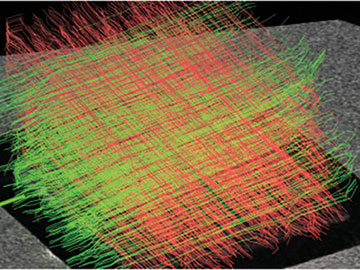
Phantom brains are cube-shaped objects containing extremely fine, water-filled microchannels the size of individual cranial nerves. [Image: Woletz et al., 2024, Adv. Mater. Technol., CC-BY 4.0 (https://creativecommons.org/licenses/by/4.0/)]
Magnetic resonance imaging (MRI) is a common diagnostic imaging technique for in vivo examination of the structure and function of the brain. A variant called diffusion-weighted MRI (dMRI), used in both clinical and research settings, can also reveal the direction of the brain’s nerve fibers. But validating the results of dMRI methods has been challenging because of the complex biophysical processes that underpin different contrast mechanisms.
Now, researchers in Austria have leveraged two-photon polymerization (2PP), a high-resolution printing method typically used for printing microstructures, to create a “phantom brain” as a test object that can do just that (Adv. Mater. Technol., doi: 10.1002/admt.202300176). They report that their phantoms—cube-shaped objects containing extremely fine, water-filled microchannels the size of individual cranial nerves—are similar enough to the brain’s white matter to be used for validating and verifying dMRI data analyses.
Printing bigger
The 2PP technique uses the nonlinear optical effect of two-photon absorption to create features smaller than a micrometer on 3D-printed objects (see “3-D Laser Nanoprinting,” OPN, October 2019). The catch is that creating such detail is a slow process, so most 2PP-printed items are in the nanometer and micrometer range.
The research team, made up of a collaboration between the Medical University of Vienna and Vienna University of Technology, scaled up 2PP in all three dimensions with two techniques. They first tackled the limitation imposed by the distance between the front lens of the objective and the focal point—the z-direction―by mounting a material vat on the objective and dipping a structure holder into the vat. This allowed the researchers to lower the objective as each layer of the printing structure was deposited, maintaining the same focal spot depth and therefore circumventing optical deviations.
Next, the team overcame the limit from the field of view of the optical components in the xy-direction by simultaneously creating multiple building blocks in separate fields of view. They found the ideal fabrication strategy to be a height (z-direction) of 300 µm and a xz-stitching angle of 12° for each block.
With these upscaling methods, the researchers created phantom brains of up to 7 × 7 × 4.2 mm3 and containing as many as 51,000 microchannels. They validated the 2PP process by printing multiple test phantoms with parallel microchannels, allowing them to ensure the reliability of the structuring power, layer spacing, throughput, structure quality and design.
Scaled-up 2PP enables the fabrication of many modifiable and customizable complex designs, modeling areas in the brain that create complicated signals, like intersecting nerve pathways.
Phantom brains
According to the team, the phantoms allow nerve structures to be assigned within the model, improving dMRI analyses. “Using the newly developed brain phantom, we can adjust the [dMRI] analysis software much more precisely and thus improve the quality of the measured data and reconstruct the neural architecture of the brain more accurately,” explained study author Michael Woletz, Medical University of Vienna, in a press release.
Scaled-up 2PP enables the fabrication of many modifiable and customizable complex designs, modeling areas in the brain that create complicated signals, like intersecting nerve pathways. Researchers should be able to calibrate the dMRI software by checking the accuracy of the results of the known and precise morphologies of the phantoms. The team hopes that their work will have clinical and research applications, aiding patients with neurodegenerative diseases.
Moving forward, Woletz and his colleagues plan on streamlining the processes even further. “The high resolution of two-photon polymerization makes it possible to print details in the micro- and nanometer range and is therefore very suitable for imaging cranial nerves. At the same time, however, it takes a correspondingly long time to print a cube several cubic centimeters in size using this technique,” says coauthor Franziska Chalupa-Gantner, Vienna University of Technology. “We are therefore not only aiming to develop even more complex designs, but also to further optimize the printing process itself.”
